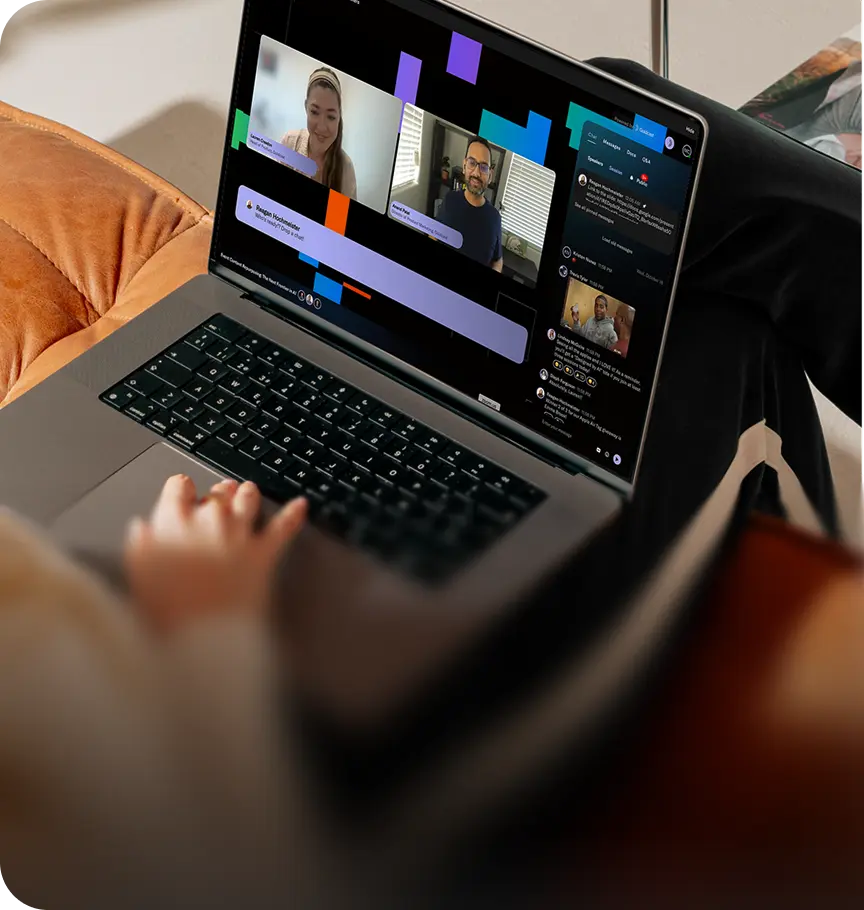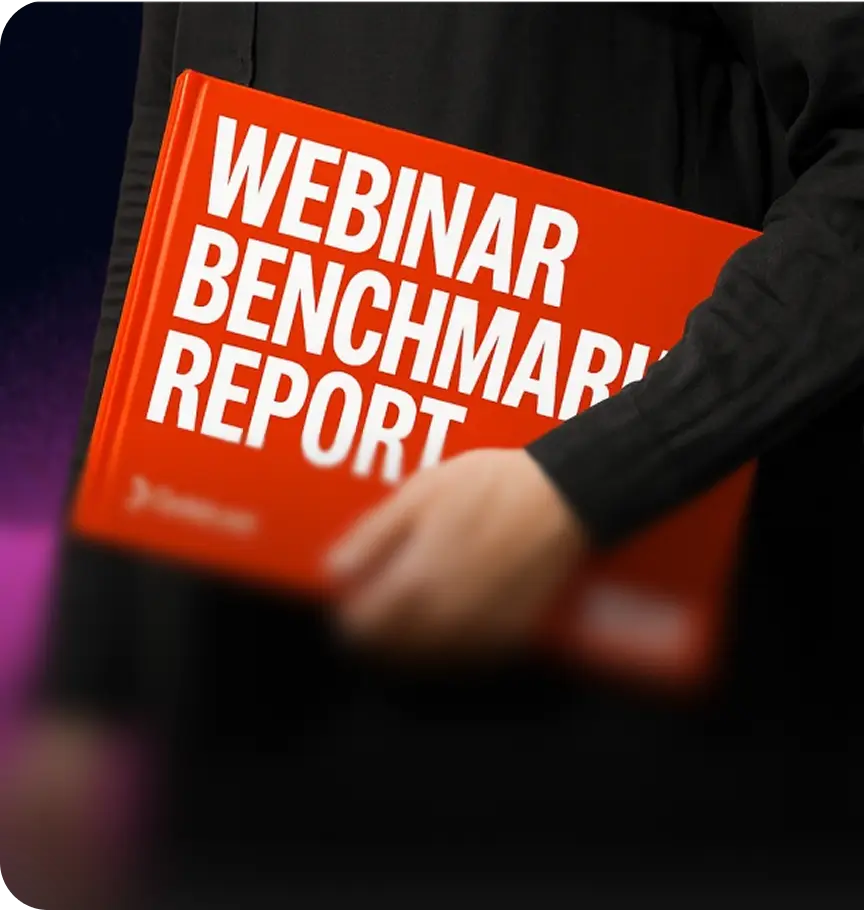Podcast Tools: From Creation to Content Engine

Table of Contents
Maximize Your Marketing ROI
Join 10,000 other marketers already getting the best tips on running engaging events that boost pipeline and create raving fans.
Want to launch a podcast that drives revenue? Skip the tool overwhelm.
Because in 2025, B2B podcasting isn’t a single content play. It’s a full-scale growth machine.
Here's how brands are building content engines that drive pipeline, while others stay stuck using basic podcasting tools.
Beyond record & release: building a podcast-first content engine
Remember when B2B podcasting was just "record, edit, publish"? Those days are gone.
Today's B2B buyers consume content like B2C consumers—they want it everywhere, all the time. Smart podcasters have caught on, turning single episodes into streams of multichannel content that never stops working.
The modern podcast engine runs on 3 cylinders:
- Creation (pro-quality recording)
- Amplification (AI-powered distribution)
- Measurement (ROI tracking)
No more amateur hour.
You need the right tools to transform episodes into business results—from high-end mics to AI repurposing engines. This guide breaks down the exact stack you need to make it happen.
1. Creation: choosing the best recording software
In 2025, video isn't optional for B2B podcasts.
While traditional audio-only shows still exist, our data shows 97% of marketers are investing in video, dedicating 10-25% of their marketing budgets to production. Why? Because B2B podcasting with video creates exponentially more opportunities to engage your audience.
With minimal extra effort, your video podcast becomes a goldmine for content repurposing. Each episode can be transformed into social media clips, email content, blog drafts and more.
But remember, even with video, audio quality is foundational. You need recording software that captures pristine sound without requiring hours of work in post-production.
🤔 Not sure which recording software is right for you? We break down all the top options in our detailed comparison guide.
Essential hardware (for any budget)
Even the best podcast tools are only as good as your setup and recording space. You don't need to break the bank, but you do need reliable recording equipment.
Mic:
- Budget choice: The Fifine USB Microphone K669 will get you up and running with surprisingly good sound quality without emptying your wallet.
- Mid-range pick: Grab the Blue Yeti USB Microphone—it's a fan favorite among podcasters for a reason. Versatile, reliable, and sounds great.
Webcam:
- Budget choice: Keeping it simple? The Logitech C270 HD Webcam has you covered with decent 720p video that won't break the bank.
- Mid-range pick: The Logitech C920 HD Pro Webcam delivers crisp 1080p quality perfect for professional podcasting.
Ring light:
- Budget choice: Check out the NEEWER RH8B 8" Desk Ring Light. It'll make you look good without overcomplicating things.
- Mid-range pick: Want the full package? The 18-inch Cordless Ring Light Pro from Lume Cube is your best bet—it's wireless, bigger, and brighter. Perfect for a polished look.
Headphones:
- Budget choice: The Sony MDRZX110/BLK ZX Series gets the job done.
- Mid-range pick: Serious about sound? The Audio-Technica ATH-M50x is what the pros reach for. Amazing sound quality and you can wear them all day without your ears hurting.
Remote podcast recording platforms
Geography shouldn't limit your guest roster. Browser-based studios make it easy to record your podcast with anyone, anywhere.
The key feature to look for? Local recording capability.
This ensures you get pristine audio/video quality, even if someone's internet gets wonky during the session.
When recording remotely, a browser-based studio with local recording capabilities gives you:
- Better quality: Captures raw, uncompressed audio/video straight from your devices (unlike cloud tools that compress files)
- Solid stability: Sidesteps internet hiccups and lag that can wreck cloud recordings
- Greater control: Lets you tweak settings like resolution, frame rates, and audio files how you want them
- Stronger security: Less risk of unauthorized access
The second must-have feature? Multi-track recording.
Multi-track recording captures separate audio and video tracks for each participant, leaving you free to:
- Mix and match content however you need (no more being locked into one version)
- Fix audio levels for each speaker independently (goodbye awkward volume differences!)
- Slice and dice segments into different formats (from LinkedIn to YouTube, you're covered)
- Polish your content to perfection with studio-quality podcast editing tools
Top remote recording platforms to consider:
- Goldcast Recording Studio: Purpose-built for B2B podcasters, offering HD local recording, text-based editing, and seamless integration with content repurposing tools
- Riverside.fm: Browser-based recording with up to 4K video quality
- Zencastr: Popular choice offering auto post-production and transcription features
For the best experience, look for platforms that:
- Require minimal technical setup from guests
- Include backup recording options
- Provide quality audio
- Offer easy ways to share and export files
- Include basic editing tools and templates
Understanding evolving podcast editing tools
Here's where things get interesting. While traditional audio editors like Audacity and Adobe Audition still have their place, text-based editing is revolutionizing post-production.
Instead of manipulating waveforms, you can edit your podcast via transcript—way faster for most marketers.
Modern editing platforms also automate many time-consuming tasks:
- Removing filler words and awkward pauses
- Trimming dead space
- Adding branded elements
- Formatting for different channels
The key is finding an all-in-one platform that combines recording and post-production. You shouldn't need professional video editing software for every episode.
Look for tools that offer:
- Automated editing features: Focus on content quality while the software handles technical cleanup
- Built-in branding tools: Easily add overlays, speaker cards, custom bumpers and more
- Multi-channel formatting: Export in the right sizes for YouTube, TikTok and other platforms
- Text-based editing: Make changes by editing a transcript rather than manipulating audio waves
Popular editing tools include:
- Descript: Known for text-based editing and AI features
- Adobe Audition: Professional-grade audio editing
- Hindenburg: Radio-style editing focused on storytelling
- Goldcast Recording Studio: End-to-end solution with all the features above, plus built-in distribution
Once your basic edit is complete, it’s all about adding the right branded touches.:
- Add intros, outros, and background music
- Apply branded elements like custom backgrounds and overlays
- Include lower-thirds and speaker cards
- Create a consistent visual identity across episodes
The right podcast editing platform turns post-production into a streamlined process that even beginners can handle—no video team required.
Capture, edit, and distribute professional podcasts from a single dashboard.
See how Goldcast Recording Studio can transform your production process.
2. Amplification: repurposing and distributing your content
Got a killer podcast episode? Great—but don't stop there.
Your hour-long conversation contains dozens of quotable moments and discussion points. Why let them live in just one format when you could be serving them up where your audience is already hanging out?
With the right podcast hosting, repurposing, and distribution tools, you can transform a single episode into a flywheel of multi-channel content.
AI podcast repurposing tools
In a buying environment where you need to be seen on all channels all the time, content repurposing is probably the most time-consuming part of podcasting.
That's where AI comes in. Modern podcasting and video tools can automatically:
- Generate accurate transcripts
- Create show notes
- Clip highlight moments for social
- Suggest the most engaging segments
Popular AI repurposing tools include:
- Goldcast Content Lab: End-to-end repurposing with brand voice preservation
- Pictory: AI-powered video editing and content creation
- Jasper: AI writing assistant for blog and social content
- Vidyo.ai: Automated video repurposing for social media platforms
Tools like Goldcast Content Lab take this even further:
- Video clips and highlights: AI automatically identifies top moments and creates shareable clips
- Blog content: Turn episodes into SEO-optimized blog posts and articles
- Social media posts: Generate platform-specific content with the right formatting and tone
- Email campaigns: Create email content that drives more engagement with your podcast
The key is finding tools that maintain quality while scaling output. With AI handling the technical aspects of repurposing, you can focus on strategy and creative direction instead of manual editing.
Ready to turn your podcast into a content engine? Try Content Lab for free and see how AI can transform your podcast workflow.
Video podcasting is non-negotiable
Nearly all top-tier podcasts now include video components, driven by discovery on platforms like YouTube and Spotify.
This isn't just following a trend—it's responding to evolving buyer expectations. Today's B2B audiences expect TV-quality production value that includes:
- Professional branding elements
- Dynamic layouts
- High-quality lower thirds
- Polished intro/outro sequences
By including video in your podcast strategy, you can:
- Expand your reach through YouTube's massive audience
- Drive stronger engagement
- Create content for social media and other channels
- Build deeper connections with your audience
- Establish a broadcast-quality brand presence
The goal isn't to simply record a conversation—it's to create a branded show that captures mindshare in a crowded market.
Unifying your content workflow
Jumping between tools is a waste of time. Every platform switch means more logins, more training—and more chances for things to go wrong.
End-to-end platforms like Goldcast Recording Studio solve this by giving you everything in one place:
- Record high-quality video and audio
- Edit quickly with AI-powered tools
- Generate clips and content automatically
- Publish directly to your channels
No more file shuffling. Just seamless podcast production that lets your team focus on creating great content, not managing tech stacks.
Ready to streamline your workflow? See how Recording Studio combines professional recording with AI-powered content creation.
3. Measurement: tracking your podcast's ROI
Download numbers are nice, but they don't tell the whole story. Modern B2B marketers need deeper insights to prove their podcast's business impact.
Data beyond download counts
Here are the key metrics to track:
- Listener engagement patterns (when people drop off, which segments grab attention)
- Geographic distribution of your audience
- Content topic performance
- Platform-specific engagement metrics
- View counts across video platforms
- Social sharing and amplification
- Website traffic driven by podcast content
The right data helps you identify which topics resonate and the types of content that keeps the pipeline moving.
Prove ROI by tying engagement to revenue
Here's where B2B podcasting truly separates itself from consumer shows. Modern platforms can:
- Track individual listener behavior
- Capture poll responses and question submissions
- Monitor resource downloads
- Sync engagement data directly with your CRM
When this behavioral data flows straight into Salesforce or Marketo, you can trace exactly how your podcast influences pipeline and revenue. 🙌
Monetization pathways for your podcast
While you can always go for traditional monetization methods like sponsorships, B2B podcasts typically drive value through:
- Lead generation and pipeline contribution
- Client relationship nurturing
- Thought leadership positioning
- Partnership opportunities
- Brand awareness and mindshare growth
The key is having tools that can connect podcast engagement to actual business outcomes.
Ready to prove your podcast's ROI? See how Goldcast's analytics provide deep insights into audience engagement and business impact.
Building your podcast tool stack
Here’s a quickstart guide to help you choose your path based on your goals and budget:
1. The bootstrapper stack (under $200/month)
✓ Creation
- Basic USB microphone
- Free recording software
- Riverside's free tier for remote guests
✓ Amplification
- Manual content repurposing
- Basic hosting plan
- Direct platform uploads
✓ Measurement
- Platform analytics
- Basic download metrics
2. The growth stack ($500-1000/month)
✓ Creation
- Professional mic setup
- Premium remote recording platform
✓ Amplification
- AI-powered content repurposing
- Multi-channel distribution tools
- Automated publishing workflows
✓ Measurement
- Advanced analytics dashboard
- CRM integration
- ROI tracking
From basic show to revenue engine
Basic podcasting tools won't cut it anymore. The most successful B2B brands are using integrated platforms to turn episodes into engines of engagement, authority, and revenue.
Want to see what modern podcast production looks like? Get started with Goldcast Recording Studio or test drive Content Lab for free.
Transform Your Video Marketing with AI
Stay In Touch
Platform
Resources
© 2025 Copyright Goldcast, Inc. All rights reserved.





 Upcoming Events
Upcoming Events Event Series
Event Series On-Demand Events
On-Demand Events

